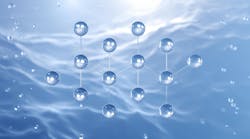A survey of more than 1,000 adults in the United States found that adults are unclear about ozone and its benefits, 40% have some understanding there is "good" ozone and "bad" ozone and other facts about ozone are less well understood, according to the lotus Oh-Zone! Awareness Survey.
Myths and misperceptions uncovered by the survey reveal that:
-- 34% of respondents reported they know ozone is safe;
-- 25% think it causes pollution while another 25% believe it is pollution;
-- 24% of respondents believe ozone creates a blue sky; and
-- 22% know that ozone is safely used to kill bacteria and germs in some municipal water systems and that ozone helps reduce indoor air pollution.
According to Steve Hengsperger, President of Tersano, Inc., sponsor of the lotus Oh-Zone! Awareness Survey, "There is much apprehension and misunderstanding regarding ozone, which is a naturally occurring molecule Mother Nature produces whenever and wherever it is needed for protection, recycling and clean up." This means that as humans dump pollutants into the atmosphere, Mother Nature must produce increasingly more ozone to clean it up, he explained.
Results of the lotus Oh-Zone! Awareness Survey have been released following the U.S. Centers for Disease Control's (CDC) Third National Report on Human Exposure to Environmental Chemicals. The report provides an ongoing assessment of the U.S. population's exposure to 148 different environmental chemicals, including those used in well-known household cleaning products, using biologic monitoring. Biomonitoring is the direct assessment of people's exposure to chemicals by measuring the chemicals of their breakdown products (metabolites) in blood or urine.
"We can significantly reduce our ingestion, inhalation and absorption of toxic chemicals simply by using a microfiber cleaning cloth dipped in water infused with ozone, also called super-oxygenated water, to sanitize countertops, cutting boards, baby bottles and household surfaces," Hengsperger said. "The result will be a reduced dependency on traditional household cleaners that contain toxic chemicals."
But are Americans ready to give up their favorite cleaners? When asked if they would be interested in a device that turns ordinary tap water into a safe, powerful disinfectant that is stronger and faster than chlorine bleach:
-- 40% of respondents said they would be positively disposed to buying such a product;
-- 25% said they do not believe such a device is possible, but would purchase it if it were available; and
-- 18% believe it is possible and would purchase such a device.
According to Hengsperger, "The water infrastructure in the U.S. is in a state of neglect and disrepair with many pipes and plants coming to the end of their useful life. Unfortunately, older systems are deteriorating at the same time federal water quality rules are being tightened. But because local budgets cannot keep pace, it's becoming increasingly important to have an extra level of protection at home that ordinary water filters alone can't provide." There are products on the way that will allow consumers to sanitize their water with ozone technology without the added expense of a whole home system, Hengsperger noted.
Ozone is a safe, colorless, naturally occurring trace gas best known for serving to absorb many harmful solar UV rays in the stratosphere. Less known is that ozone is one of the most powerful natural sanitizing and disinfecting agents in the world, killing up to 99.99999999 percent of bacteria such as e-coli on contact.
Because super-oxygenated water is over 50 times more powerful and over 3,000 times faster acting than chlorine bleach, it has been used as a water disinfectant in Europe since the 1800s and is used by most water bottling plants and many municipal water systems in the U.S.
The Joseph P. Jensen Water Treatment Plant is the largest water treatment plant in the U.S. to employ ozone disinfection. The California plant provides up to 750 million gal of treated water each day to agencies in Ventura, Los Angeles and Orange Counties. Currently, the plant is in the process of switching its primary disinfectant from chlorine to ozone for more aesthetic water that reduces potential health concerns. This will be achieved by destroying a wider range of organisms in drinking water, removing most objectionable tastes and odors and producing fewer potentially harmful byproducts than the traditional chlorine treatment.
Source: Tersano, Inc.

